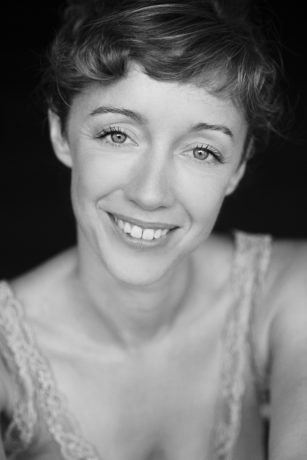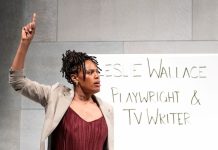In San Francisco, the Unbound Festival included twelve choreographers and was a massive undertaking filled with phenomenal risks, tremendous creative freedom and the excitement of new territory. For their performance at the Kennedy Center, San Francisco Ballet brings nearly the full company of dancers and six dances from Unbound. The two programs, from October 23-28, feature works by choreographers Edwaard Liang, Trey McIntyre, Justin Peck, and Christopher Wheeldon plus Washington, D.C. debuts by Cathy Marston and David Dawson.

Performed in pointe shoes or sneakers, inspired by literary narrative or distilled in partnering and shapes, the two programs are performed to varied contemporary, folk and classical music and some employ innovative set designs. Choreographer Cathy Marston makes her Kennedy Center debut with “Snowblind” based on Edith Wharton’s 1911 novella “Ethan Frome.”
Jane Franklin: How much time did you have with the dancers?
Cathy Marston: Three weeks of creation time in August (of 2017) plus some extra rehearsal to re-rehearse the piece before the premiere in the spring.
What research took place before you met with the dancers? Did you find the movement ideas through improvisation with the dancers?
Before I met the dancers I read “Ethan Frome” several times, and worked on a dance adaptation with designer Patrick Kinmonth. I then collaborated with Philip Feeney on a musical arrangement which included piano pieces by Arthur Foote and Amy Beach, orchestra pieces by Arvo Pärt, as well as original music by Feeney which brought the whole work together. Finally, before coming to the studio I wrote lists of words describing each character – Ethan, Zeena, and Mattie – as well as words that described different qualities of snow. I then used these word lists as prompts for improvisation tasks with the dancers.
Some of the material in the final choreography derives from these tasks, but they also serve to develop the way the characters move. Another question I asked of the dancers in these early rehearsals was “which steps from a ballet vocabulary might fit your character’s language?” I find it helpful to know if a character’s movement is primarily linear/curvy, sharp/lyrical, floor-bound/air-bound. Of course, this might change throughout the course of the piece.
When did the music or sound come into the process?
The music came after I’d developed the scenario with Patrick Kinmonth, but before the choreography. We chose Amy Beach and Arthur Foote as anchors for the work because their music was written in Boston around the same time that Edith Wharton based the novella, so without using big sets and costumes we could already give the work a sense of time and place. I wanted Arvo Pärt for the final section of the ballet where Ethan and Mattie recklessly throw themselves into the snowy elements because this feels like a monumentally emotional act that I feel is reflected in Pärt’s work. Some of the sections needed original music and Philip provided this brilliantly, taking tiny motifs from the existing works so there’s a cohesive feeling to the ballet overall.
How closely did you work with the narrative?
I work very closely with the narrative and talk about the characters’ actions, motivations, desires, and emotions constantly with the dancers. We often refer back to particular moments in the text, and although they might not be obvious to the audience in the end, the fact that the dancers are so clear about the subtext of the movement adds to the conviction with which they can perform it.

There is no dialogue in the dance – how does the movement replace the written word?
I think there’s a dialogue of movement in the piece, and the dancers are very clear – especially in the duets and trios – about what the conversation is. Some things, of course, are not actually expressed in words – even in the book – and that’s where dance can really add to the story. We can express so much in a touch that is very hard in concrete words. The way I use the group, however, as “Snow” – representing the environment but also the emotional journey of the characters, is actually more expressionistic, I would say.
There is a larger cast that represents snow. Are there any other landscapes from the story that you strove to recreate with the movement of the larger group?
There’s a couple of group scenes in which the corps de ballet are “neighbors” of the protagonists, but mainly they are snow. I was interested in how snow can change quality – it can be soft, caressing, hypnotizing, but also stinging, vicious, suffocating, silencing.
How did the partnerships work? And how did you develop the weight-sharing moments? Was this something that came out from the actual physical bodies of the dancers?
I work with a mix of “ballet partnering” where the man tends to lift and support the woman, together with more “contact-style” partnering, where weight is shared between the dancers and momentum plays a bigger role. I find this combination can offer more range in what it expresses, and gives the female dancer a more proactive role, giving all dancers a much wider range in the emotions they can convey.
How was it to work with the members of the San Francisco Ballet?
Great. They are technically brilliant, and while this was a new sort of process for them I think they were excited by how it turned out!
I notice you have worked with the Washington Ballet previously. Where do you call home and how much do you travel each year?
I made a seven-minute work for the Washington Ballet in a program called 7×7, commissioned by Septime Weber quite a while back! I live in Bern, Switzerland, with my husband (an engineer) and two children – aged three and six. It’s hard work making all my traveling work with the family, but there are rewards too! We are about to fly to Cuba all together, combining my upcoming premiere for the Cuban National Ballet with a holiday together. I come from Cambridge, and this, along with London, is still very much part of who I am.
San Francisco Ballet: 2 PROGRAMS of East Coast Premieres from Unbound: A Festival of New Works plays October 23-28, 2018, at Opera House Orchestra performing at The John F. Kennedy Center for the Performing Arts – 2700 F Street NW, in Washington, DC. For tickets, call the box office at 202-467-4600 or go online.




